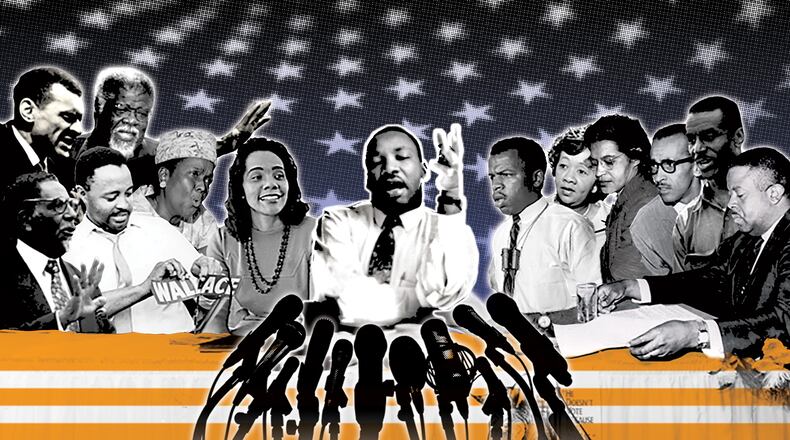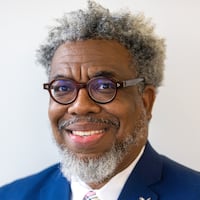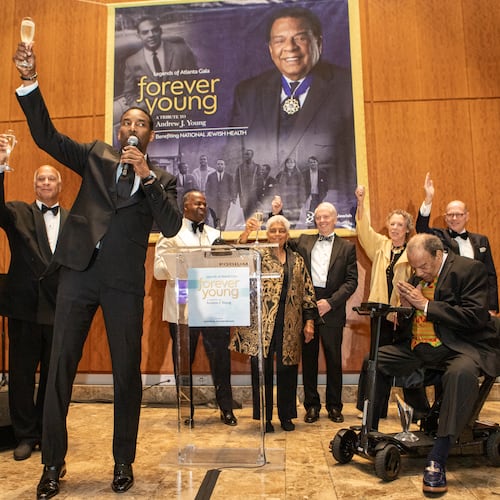A decade into The Atlanta Journal-Constitution’s Black History Month series, we have produced more than 300 pieces of original content to help tell the story of a culture. That is a lot of work, but it is important and well worth it.
Throughout this month, with “Atlanta Unveiled: How African Americans Shaped Our City” we mark 10 years of coverage and occasionally step back to revisit some of our best work.
There are a lot of stories to tell in Atlanta. That is no surprise from a city that has produced, nurtured and inspired the likes of the Rev. Martin Luther King Jr., C.T. Vivian, James Orange, Joseph Lowery, Hosea Williams, Ella Baker, Coretta Scott King, John Lewis, Dorothy Height, Rosa Parks, Wyatt T. Walker, Fred Shuttlesworth and Ralph David Abernathy.
Today, we look at some our best profiles.
The Return of Muhammad Ali
It was October 1970 and Muhammad Ali, the former heavyweight champion of the world, hadn’t fought in three and a half years. America was divided as ever as the Vietnam War raged overseas and young men were drafted to fight — and often die — right out of high school. Stripped of his title at the height of his career and banned from the ring for refusing to join the war after being drafted, the undefeated and seemingly rusty Ali made his return to boxing in Atlanta as the world looked on. It was glorious. The story by Shaddi Abusaid recalled the mood and atmosphere around Atlanta that day. But because Ali was “The Greatest,” one profile can’t contain him. That is why Tia Mitchell, a native of Louisville, talked to people back home in the “City of Ali,” to dig into her roots, and the champ’s.
The Voices
Credit: AJC file photos
Credit: AJC file photos
The series has written about many female musical artists, from Lauryn Hill to Gladys Knight to Josephine Baker.
But nothing compares to sitting in Millie Jackson’s living room and listening to her tell rollicking stories about her amazing career. Or quietly listening to opera legend Mattiwilda Dobbs, the aunt of former Atlanta Mayor Maynard Jackson, with members of her family. Or sitting in the kitchen with South Fulton Councilwoman Linda Becquer-Pritchett in front of a stack of photo albums full of pictures to her “tia,” Celia Cruz.
Cecil Williams’ high-risk drink of water
Credit: Courtesy Cecil Williams
Credit: Courtesy Cecil Williams
Cecil Williams was just thirsty.
And in 1956 in rural South Carolina, being thirsty could get you lynched. But there he was on Highway 21 on his way back home to Orangeburg, when he stopped at a service station to get a drink of water only water fountain, which marked “white only.” By chance, a friend of his snapped his photo.
“It was dangerous to do things like that during that era,” Williams said. “Grave things happened to people of color when we broke the rules.”
Katherine Johnson, a hidden figure
Credit: NASA
Credit: NASA
Katherine Johnson’s skill at working complicated calculations essential to space travel was simply unparalleled. Working as a NASA “computer,” her work was instrumental in advancing the country’s standing in the Space Race.
Her calculations helped plot the successful 1961 Mercury flight of Alan B. Shepard Jr., when he became the first American in space only to top that a year later when she helped John Glenn orbit the earth. But most significantly, she calculated the precise trajectories that would let Apollo 11 land on the moon in 1969 and, after Neil Armstrong’s history-making moonwalk, return to Earth.
Yet throughout her 33 years in NASA’s Flight Research Division and for decades afterward, she remained a “Hidden Figure.”
Hubbard Pryor, Sojourner Truth and the search for self
Credit: U.S. National Archives
Credit: U.S. National Archives
Emancipation, in any form, carries a lot of weight. Of special importance is what one does with it. Here are two people who established their own unique paths after they escaped from slavery. For Hubbard Pryor, who escaped from slavery in 1864, it meant taking up arms as a Union soldier to fight against his former oppressors.
Credit: Hyosub.Shin@ajc.com
Credit: Hyosub.Shin@ajc.com
For Isabella Van Wagenen, it meant escaping slavery in 1826 and spending the rest of her life fighting against the institution and for women’s rights. But freedom to her also meant the opportunity to choose who she wanted to be. So in 1843, she shed her “slave name,” and became Sojourner Truth.
Mother Mathilda Beasley: The mystery of Georgia’s first Black nun
Credit: Courtesy of Georgia Historical Society
Credit: Courtesy of Georgia Historical Society
Mother Mathilda Beasley died in 1903 in a small cottage owned by a Catholic church. She was worshipping at an altar she had built inside, and lying next to her were burial clothes, a will and instructions for her funeral. The details of her death stand in stark contrast to the many things that aren’t known about the life of Georgia’s first Black nun.
It’s unknown how Beasley, who was born into slavery in New Orleans and whose father was likely Native American, obtained her freedom. It’s unknown how she made her way to Savannah. Some even question what she looked like. What we know is that in 1850, she risked severe punishment, and perhaps her own liberty, by opening a secret school to teach Black children how to read and write.
Tiger Flowers, the ‘Georgia Deacon’
Credit: Courtesy of the Atlanta History Center
Credit: Courtesy of the Atlanta History Center
Long before Evander Holyfield, Atlanta had another champion who helped put the city’s boxing scene on the map. In 1926, Theodore “Tiger” Flowers became the first Black man to win the world middleweight championship.
Inside the ring, the evasive southpaw racked up the wins, defeating some of the top boxers of his time on the way to the title. The well-liked prizefighter was known as “The Georgia Deacon” because he was a devoutly religious man who spent his Sunday mornings serving as a steward at the Butler Street CME Church.
The Horne
Credit: Library of Congress
Credit: Library of Congress
Before there was Beyoncé, there was Lena.
Or, as Fred Sanford lustily called her, “The Horne.”
For more than seven decades, particularly in the 1930s and 1940s, no Black female artist shined as bright as Lena Horne. And perhaps none had as much pressure.
Only the second African American performer to sign with a major motion picture studio, Horne, with her stunning looks and soaring voice, became a popular figure in movies, on records and at concert halls. And while other Black female performers, at least in the movies, were often regulated to servant roles, Horne — the daughter of privilege who was raised partly in Atlanta — refused to play the maid or the nanny.
“I was unique in that I was a kind of Black that white people could accept,” she once said. “I was their daydream. I had the worst kind of acceptance, because it was never for how great I was or what I contributed. It was because of the way I looked.”
A little child shall lead them
Credit: AJC file photos
Credit: AJC file photos
It was no secret that one of the key strategies of the Civil Rights Movement, was to employ children and teenagers in marches, sit-ins, boycotts, school strikes and attempts to integrate schools.
Every day, to get to school in the morning, 6-year-old Ruby Bridges walked through a terrible gauntlet of hateful people shouting threats and curses on her way to William Frantz Elementary School in New Orleans. Several months before Rosa Parks was arrested for not moving to the back of a Montgomery, Alabama bus, 15-year-old Claudette Colvin, who was unmarried and pregnant, was arrested under the same charge. Diane Nash was older, barely 21 years old when she first joined the movement. But her impact was immense as a member of the Student Nonviolent Coordinating Committee and the Nashville Student Movement.
Credit: Courtesy of LuLu Brizzell
Credit: Courtesy of LuLu Brizzell
A few generations later, 11-year-old Mari Copeny came along. Known as “Little Miss Flint,” she became the face and voice of the 2014 Flint water crisis, where more than 100,000 Michigan residents were exposed to contaminated, lead-tainted drinking water.
Angelo Herndon: How a Black communist defeated Georgia’s insurrection law
Credit: Associated Press
Credit: Associated Press
In January 1933, Angelo Herndon, a 19-year-old Black worker accused of “attempting to overthrow the lawfully and constituted authority of the state of Georgia,” stood in front of a packed courtroom and delivered a social commentary that is eerily relatable today.
“The present system under which we are living today is on the verge of collapse; it has developed to its highest point and now it is beginning to shake,” said Herndon, who was charged under Civil War era insurrection laws.
Herndon, an avowed communist, had organized roughly 1,000 unemployed Black and white workers to march at the Fulton County Courthouse to demand financial assistance after the state dropped 23,000 families from the relief rolls during the Depression. Their peaceful protest was successful, but Herndon was later arrested and jailed. His fate, resting in the hands of an all-white jury.
Chef Mashama Bailey on bringing ‘Black Power’
Female, chef, restaurateur. Each of those descriptions would be correct in association with Mashama Bailey, but the James Beard award-winning executive chef and partner of celebrated Savannah fine-dining restaurant the Grey has also emerged as one who brings a “little bit of Black Power” to the plate.
“Black Power is not about exercising power over white people,” she wrote in her memoir, “Black, white, and the Grey.” “It is not about stereotypes of Black culture or validating those things. It is about understanding that we are in a subjugated position, shining a light on that fact and helping each other by creating and sharing opportunities for self-determination.”
ABOUT THIS SERIES
This year’s AJC Black History Month series, marking its 10th year, focuses on the role African Americans played in building Atlanta and the overwhelming influence that has had on American culture. These daily offerings appear throughout February in the paper and on AJC.com and AJC.com/news/atlanta-black-history.
Become a member of UATL for more stories like this in our free newsletter and other membership benefits.
Follow UATL on Facebook, on X, TikTok and Instagram.
About the Author
Keep Reading
The Latest
Featured













![[Cropped for promo]](https://www.ajc.com/resizer/v2/V2HRMZBWP5CRJCLEYMR5Z5D4TI.jpg?auth=d37c9dcc09754daee1e93c58cef0730752e54b7b44cdd5dc4bf862ad5c3dc546&width=600&smart=true)




